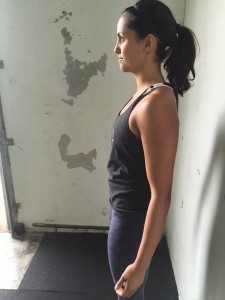Those of you who train with us might have noticed that I’m a bit of a stickler when it comes to rib positioning. As annoying as I’m sure my constant rib reminders are, there’s a reason for them. I recently took a course with the Postural Restoration Institute that totally changed my perspective. While there I learned that rib misalignment is a frequently overlooked aspect of training that when corrected, can make significant changes in your performance, posture, injury prevention, and rehabilitation.
Rib flare is easily identified when you can see your bottom ribs protruding. This often worsens when you reach your arms overhead. Rib flare also tends to be more prominent on the left side of your body, since that’s where your internal organs are situated.
Check out the pictures below for an example of flared and depressed ribs.


So why do some people get the shaft with rib flare?
- Genetics (common mom!)
- Breathing – When you carry stale air in the lungs and don’t learn how to fully exhale, rib flare becomes more prominent
- Stress – People who are in a constant state of stress tend to also be in a constant state of inhalation, which feeds the rib flare fire
Why Rib Flare SUCKS!
Okay I know. You may be thinking, “Why should I care about rib flare?” Which is a valid question. Yes protruding ribs aren’t overly aesthetically pleasing, but I assure you there are more reasons to want to rectify your rib flare if you suffer from it. Here’s a few of them:
1. When your ribs are flared, there is no integration between your diaphragm and the abdominal muscles.
When you have good rib positioning, the overlap of your diaphragm and abdominal muscles is called a ZOA, or zone of apposition. When your ribs are flared, the ZOA is lost, causing poor diaphragmatic pressure (aka not so great breathing) and poor activation of your abdominals.
2. It’s impossible to come into a truly full exhale when your ribs are stuck in a flared position.
Without the ability to exhale all of your stale air, it’s not only difficult to create a ZOA, but it is also more challenging for your body to get into a parasympathetic “rest & digest” state.
Try this: Inhale all the way, flare your ribs and hold your breathe. I think that you’ll find that it doesn’t take long to get your body into your parasympathetic “fight or flight” state. Now imagine being stuck in this state on a regular basis. Sounds pretty horrible, right?
3. When your ribs are pulled into flare at the front, your upper back, or thoracic spine gets pulled forward into extension.
Your shoulder blades glide best on a nice kyphotic curve of the spine. However when it’s in extension, scapular glide, shoulder range of motion and stability can become compromised. This posture can cause muscles like your lower trapezius and the serratus anterior to weaken; which is less than ideal as both muscles are essential to your shoulder health.
Read THIS post if you want to learn more about how you can improve your shoulder mobility.
4. When your ribs are flared, your lumbar spine is pulled forward into an excessive extension and your pelvis goes into anterior tilt.
I could write an entire post about why excessive lordosis and anterior pelvic tilt (APT) are the devil. But in short, they can cause your hip flexors and back extensors to tighten, while your abdominals, glutes and hamstrings weaken; which eventually will wreak havoc on your back.
The Coles Notes version: Everything is connected. If you have poor rib positioning, you’re at an increased risk for shoulder and back dysfunction. Not to mention the negative repercussions associated with being in a constant “fight or flight” sympathetic state. So don’t overlook it, okay?!
Now for the important part, how you can fix rib flare!
Now that you know why you should care about rib flare, it’s time to discuss how to fix it.
1. First and foremost, you MUST have the ability to breathe well.
If you can’t expand well through the front, back and sides of your diaphragm during inhalation, and take a FULL exhalation, then you have some work to do. Check out this video for some helpful breathing tips. After that, try the exercise below.
2. Choose the right core and stability exercises.
Destroying your abs with endless crunches every workout will likely not fix your rib flare or improve your ZOA. Instead, try the two exercises below with lower, controlled reps to reinforce good rib positioning and pelvic tilt. For more info on how to engage your core effectively, checkout this article.
PRO TIP: To set your ribs during these exercises, take a giant exhale, like you’re blowing out candles on a birthday cake. This will cause your ribs to naturally depress. After that try your best to continue with a normal breathing cadence and keep them there.
3. Watch your posture.
Once you’ve locked down good rib positioning during the exercises above, ensure that you are conscious of your posture during your bigger lifts. Below is an visual example of what happens when your lumbar spine is being pulled into extension when your ribs are flared, as well as a photo of what your ribs should look like when you’re performing a lift. Make sure you stick with the latter.
Ribs flared Ribs down
If you’re currently suffering from rib flare, I guarantee that your lifts will feel stronger and you will reduce your chance of injury if you implement all of the techniques listed above.
If you’d like help improving your posture so that you can feel stronger and reduce your chance of injury, schedule a free fitness assessment with us.







